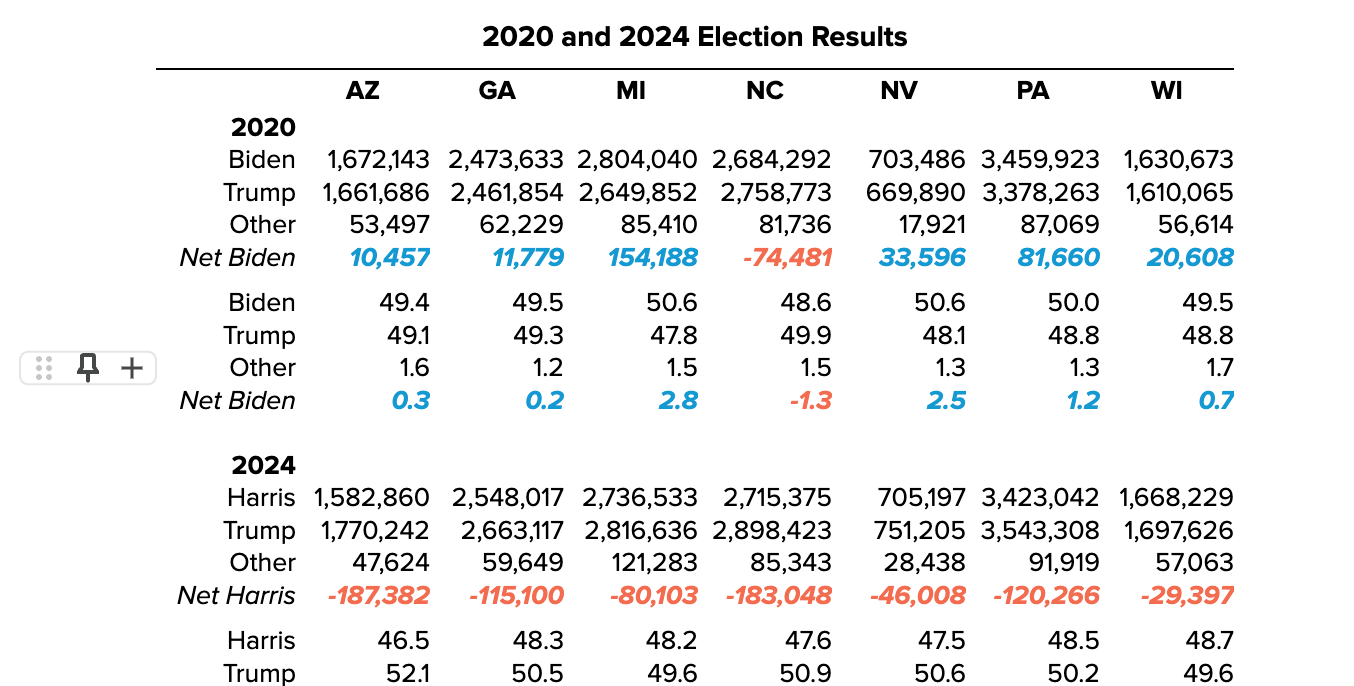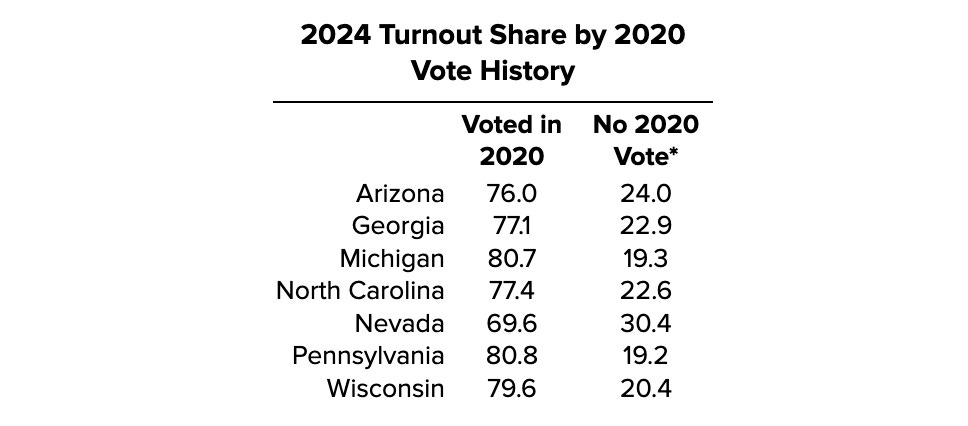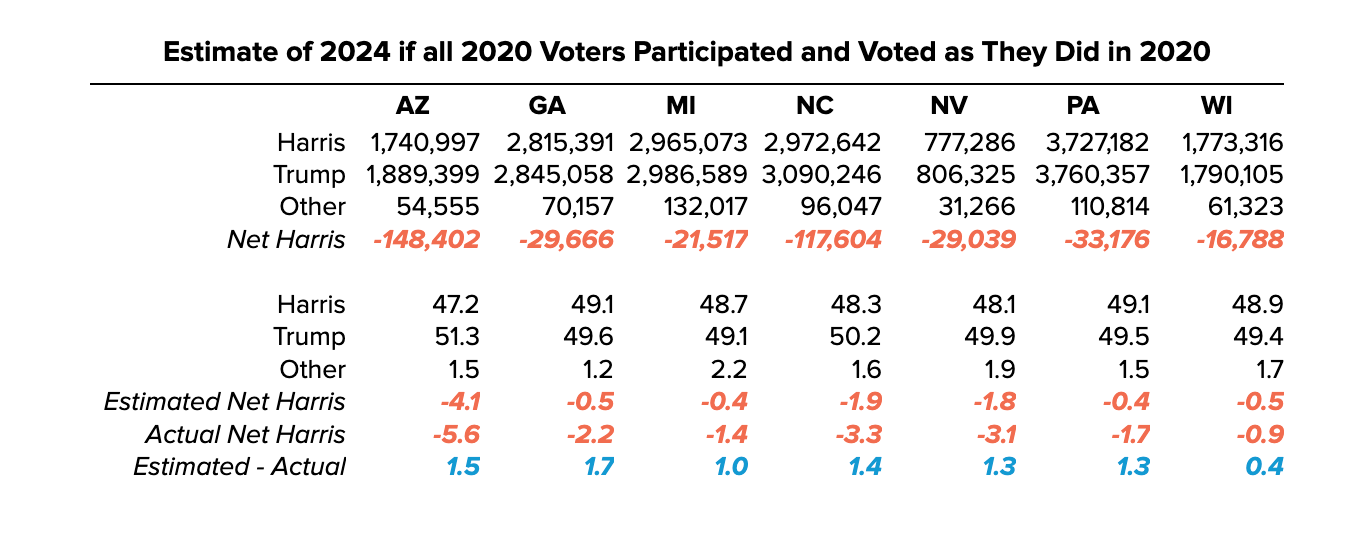
Why did Kamala Harris lose last November? Three answers have been prominently offered:
Too many 2020 Biden voters stayed home,
Too many 2020 Biden voters changed their minds, or
New 2024-only voters broke heavily for Donald Trump.
This question becomes easier to answer once states release the records of who voted and who did not. The following analysis represents the first in a Change Research series assessing which answer best answers the question of why Kamala Harris lost.
We used Change Research’s 2020 vote choice model to estimate the composition of Joe Biden and Donald Trump voters in the 2024 electorate. We found that even with adding in the 2020 Biden voters who didn’t vote in 2024, to the Harris vote, the outcome would have been the same. Kamala Harris would still lose.
Harris Lost Ground In All Seven Swing States
In 2020, Joe Biden won six of these seven states narrowly, ranging from 0.2 points to 2.8, while losing North Carolina by 1.3 points. In 2024, Kamala Harris lost them all by between 0.9 and 5.6 points.
The composition of 2020 versus non-2020 voters in each state varied from 70% to 80% of voters who voted in that state.1 Nevada had the highest share of new voters and Pennsylvania the lowest.
Change Research’s 2020 vote choice history score, allows us to estimate the 2020 vote by those who voted in 2024 and those who did not. Narrowing down to those who voted in both elections, there were more Biden than Trump voters in the Georgia, Michigan, and Pennsylvania electorates. There were more 2020 Trump voters in the Arizona, North Carolina, and Wisconsin electorates. Assuming no one changed their mind, Kamala Harris would have won by a 276-262 margin in the Electoral College if only these voters participated. Looking at those who voted in 2020 but not in 2024, and are marked as ‘active’ on the voter file, there were substantially more Biden than Trump voters in each state. This suggests that turnout could have played a decisive role in the 2024 outcomes.
2020 Voters Who Sat Out in 2024 Were Mostly Democrats
Adding together all 2020 voters, those who voted in 2024, and those who did not, Kamala Harris would have also won Nevada, along with Georgia, Michigan, and Pennsylvania, if no one changed their mind. While some people theorize that these 2020 dropoff voters would have gone for Trump by a greater margin than they did in 2020, we can’t know this since they didn’t actually vote. We can only estimate how they voted in the last presidential election.
Turnout in 2024 Could Have Led to a Harris Win… If She Hadn’t Lost Any of Biden’s Supporters
Since the 2024 election was also open to new voters, there is limited utility in looking at scenarios that exclude them. Using the actual 2024 election results and our models, the table below estimates the Harris and Trump vote shares among the 2024-only voters. The estimates below assume that no one who voted in 2020 changed their minds. Harris lost the most ground in Michigan with new voters, followed by Arizona and Georgia. She only won new voters in Wisconsin. In our next report, we plan to create 2024 vote choice history scores to get a more precise read on the impact of vote switching versus the undeniable pro-Trump skew of 2024-only voters. We expect that the Trump margins below will not be as large once we factor in vote switching.
Differential Turnout Did Not Decide the Election
Adding all these voters together - 2020 and 2024 voters, 2020 dropoff voters, and 2024 only voters - Kamala Harris moves the final margin in these states in her direction by between one and one and a half points. While this indicates some impact of differential turnout dropoff, it would not have been enough to win any of the states that decided the election. The ability to persuade new voters was the key to victory.
Change Research represents the next generation of political polling and opinion research. Change Research’s Dynamic Online Sampling approach provides faster, more representative access to public opinion data on the pressing issues of our time. Change Research is a polling and analytics company dedicated to providing accurate and transparent public opinion research. As members of AAPOR's Transparency Initiative, Change Research discloses all relevant details about its research methodologies. The methodology used for this research can be found here.
Stephen has conducted several thousand polls for campaigns, candidates, nonprofits, and others during his 30-year career in survey research. He has worked on polls supporting candidates for President, U.S. House, U.S. Senate, Governors, Mayors, and state legislators. Working with state-based nonprofits, he has developed polling to support progressive initiatives in state legislatures and was the primary researcher for Progress Now Virginia’s Progressive Narrative project and has worked on several data modeling projects in Colorado, North Carolina, and New Mexico. He holds an MA in Applied Statistics from George Mason University and a BA in Political Science and Economics from UC Berkeley. Stephen resides in the Virginia suburbs of Washington, DC.
Our voter data provider L2 does not carry over vote history for new state residents











Hey Stephen, wanted to flag something. I read this quickly and I'm in the middle of getting a big report out myself but it looks like this is looking at survey data and the two-way, not the file, yes? What some initial back of the napkin analysis found seems to indicate there was a LOT of Biden '20 dropoff and churn that you won't see in net turnout + survey data alone. Mike Podhorzer gets into it in some detail here but the evidence so far seems to suggest we can't definitively say she didn't lose to the couch. At the very least it seems like it was a significant part of it -
https://www.weekendreading.net/p/how-trump-won
C'mon, she can't even SPELL 'genocide'!